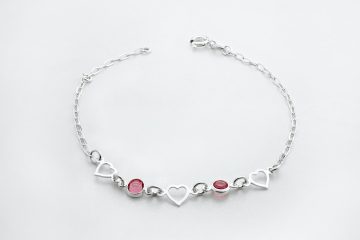Have you ever wondered why certain pieces of jewelry are named the way they are? For instance, why is a piece of wrist jewelry called a bracelet and not a wristlet? The world of jewelry is filled with fascinating naming conventions that have evolved over centuries. In this article, we will delve into the origins and history of jewelry names, specifically focusing on the term “bracelet” and its alternatives. So, grab a cup of tea, sit back, and let’s explore the enchanting world of jewelry nomenclature together!
1. The Evolution of Jewelry Names
Throughout history, jewelry has been an integral part of human culture and self-expression. From ancient civilizations to modern times, people have adorned themselves with various types of jewelry, each with its own unique name. These names have evolved over time, influenced by language, culture, and fashion trends.
2. The Origin of the Term “Bracelet”
The term “bracelet” finds its roots in the Old French word “bracelet,” which means a small or ornamental armlet. The French word itself is derived from the Latin word “brachile,” which means arm. Interestingly, the term “bracelet” was originally used to describe a piece of jewelry worn around the upper arm rather than the wrist.
3. The Emergence of Wrist Jewelry
As fashion trends evolved, so did the way jewelry was worn. In the late 19th and early 20th centuries, wristwatches became popular, leading to the emergence of wrist jewelry. However, instead of coining a new term for this type of jewelry, the existing term “bracelet” was extended to include pieces worn around the wrist.
4. The Naming Conundrum: Bracelet vs. Wristlet
Now, let’s address the perplexing question: why isn’t a bracelet called a wristlet? While the term “wristlet” seems logical, it hasn’t gained as much popularity as “bracelet.” One possible reason for this is the historical association of the term “bracelet” with jewelry worn on the upper arm. This association has likely influenced the term’s continued usage for wrist jewelry.
5. The Power of Tradition and Convention
Language is deeply rooted in tradition and convention. Once a term becomes established and widely used, it can be challenging to introduce a new term, even if it seems more logical. “Bracelet” has become the conventional term for wrist jewelry, and its familiarity and historical usage have contributed to its enduring popularity.
6. Cultural Influences on Jewelry Naming
The naming of jewelry is also influenced by cultural factors. Different cultures have their own unique terms for various jewelry pieces. For example, in India, the term “bangle” is commonly used to describe rigid bracelets made of metal or glass. In contrast, Western cultures predominantly use the term “bracelet” for similar jewelry items.
7. The Allure of Alliteration: Bracelets and Bangles
One possible reason why the term “bracelet” has prevailed over “wristlet” is the allure of alliteration. The repetition of the ‘b’ sound in “bracelet” and “bangle” adds a certain charm to these terms and makes them more appealing to the ear. This linguistic phenomenon might have played a role in the continued popularity of these terms.
8. The Impact of Marketing and Branding
Marketing and branding also influence the popularity and acceptance of certain jewelry terms. Over time, jewelry designers, manufacturers, and retailers have used the term “bracelet” extensively in their marketing campaigns, solidifying its position as the go-to term for wrist jewelry. This widespread usage has made “bracelet” the norm, overshadowing alternatives like “wristlet.”
9. The Role of Fashion Trends
Fashion trends have a significant influence on jewelry naming conventions. As styles change, new terms may emerge to describe innovative designs or materials. For example, terms like “charm bracelet” and “beaded bracelet” have gained popularity to describe specific types of bracelets with distinct features. These new terms reflect the evolving nature of fashion and the need to categorize and differentiate various jewelry styles.
10. The Varied World of Wrist Jewelry
While “bracelet” is the most commonly used term for wrist jewelry, it’s worth noting that there are alternative names for specific types of bracelets. For instance, a delicate chain bracelet with a decorative plate is often referred to as an “ID bracelet” or an “identity bracelet.” Similarly, a rigid bracelet with an opening clasp is called a “bangle.”
11. The Influence of Language and Translation
The naming of jewelry is not limited to the English language. In different languages around the world, there are unique terms that describe various types of jewelry. When translating jewelry names, cultural nuances and language-specific associations come into play. For example, the term “bracelet” in Spanish is “pulsera,” while in French, it is “bracelet,” harkening back to its original etymology.
12. The Future of Jewelry Naming
As with any aspect of language and culture, jewelry naming conventions will continue to evolve. With the advent of new materials, technologies, and design trends, new terms may emerge to describe innovative jewelry pieces. However, the enduring popularity of the term “bracelet” suggests that tradition and convention will continue to play a significant role in shaping jewelry names.
13. Conclusion
In conclusion, the term “bracelet” has stood the test of time as the preferred name for wrist jewelry, despite the logical alternative of “wristlet.” The historical association of “bracelet” with upper arm jewelry, the power of tradition and convention, cultural influences, and the impact of marketing and fashion trends have all contributed to the continued usage and acceptance of this term. While there are alternative names for specific types of bracelets, “bracelet” remains the general term that encompasses wrist jewelry in the English language.
FAQs
Q1. Are there any other alternatives to the term “bracelet” for wrist jewelry?
Yes, there are alternative names for specific types of bracelets. For example, a delicate chain bracelet with a decorative plate is often referred to as an “ID bracelet” or an “identity bracelet.” Similarly, a rigid bracelet with an opening clasp is called a “bangle.”
Q2. Why do some cultures use different terms for wrist jewelry?
Different cultures have their own unique terms for various jewelry pieces. This is influenced by cultural factors, historical traditions, and language-specific associations. For example, in India, the term “bangle” is commonly used to describe rigid bracelets made of metal or glass.
Q3. How do fashion trends influence jewelry naming conventions?
Fashion trends have a significant influence on jewelry naming conventions. As styles change, new terms may emerge to describe innovative designs or materials. For example, terms like “charm bracelet” and “beaded bracelet” have gained popularity to describe specific types of bracelets with distinct features.
Q4. Can jewelry names vary in different languages?
Yes, the naming of jewelry is not limited to the English language. In different languages around the world, there are unique terms that describe various types of jewelry. When translating jewelry names, cultural nuances and language-specific associations come into play.
Q5. Will jewelry naming conventions continue to evolve in the future?
Yes, as with any aspect of language and culture, jewelry naming conventions will continue to evolve. With the advent of new materials, technologies, and design trends, new terms may emerge to describe innovative jewelry pieces. However, tradition, convention, and the enduring popularity of certain terms will likely continue to shape jewelry names.




